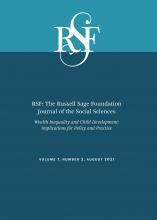Research Article
Open Access
The Effects of State-Level Medicaid Coverage on Family Wealth
Margot Jackson, Chinyere Agbai, Emily Rauscher
RSF: The Russell Sage Foundation Journal of the Social Sciences August 2021, 7 (3) 216-234; DOI: https://doi.org/10.7758/RSF.2021.7.3.10
Margot Jackson
aAssociate professor of sociology at Brown University, United States
Chinyere Agbai
bPhD student in sociology at Brown University, United States
Emily Rauscher
cAssociate professor of sociology at Brown University, United States

REFERENCES
- ↵
- Biasi, Barbara
- ↵
- Brown, David W.,
- Amanda E. Kowalski, and
- Ithai Z. Lurie
- ↵
- Burbidge, John B.,
- Lonnie Magee, and
- A. Leslie Robb
- ↵
- Bureau of Labor Statistics, U.S. Department of Labor, and National Institute for Child Health and Human Development
- ↵
- Card, David, and
- Lara D. Shore-Sheppard
- ↵
- ↵
- Conley, Dalton
- ↵
- Coyer, Christine, and
- Genevieve M. Kenney
- ↵
- Currie, Janet
- ↵
- Currie, Janet, and
- Jonathan Gruber
- ↵
- Cutler, David M., and
- Jonathan Gruber
- ↵
- Dettling, Lisa J.,
- Joanne W. Hsu,
- Lindsay Jacobs,
- Kevin B. Moore, and
- Jeffrey P. Thompson
- ↵
- Dubay, Lisa, and
- Genevieve M. Kenney
- ↵
- Du Bois, W. E. B
- ↵
- Edelstein, Sara,
- Heather Hahn,
- Julia Isaacs,
- Ellen Steele, and
- C. Eugene Steuerle
- ↵
- ↵
- Faber, Jacob William
- ↵
- Finkelstein, Amy,
- Sarah Taubman,
- Bill Wright,
- Mira Bernstein,
- Jonathan Gruber,
- Joseph P. Newhouse,
- Heidi Allen,
- Katherine Baicker
- ↵
- Freedman, David A
- ↵
- Freund, David M. P
- ↵
- ↵
- ↵
- Gluckman, Petter D., and
- Mark A. Hanson
- ↵
- Goodman-Bacon, Andrew
- ↵
- Government Accountability Office
- ↵
- Gross, Tal, and
- Matthew J. Notowidigdo
- ↵
- Gruber, Jonathan, and
- Aaron Yelowitz
- ↵
- Hannagan, Anthony, and
- Jonathan Morduch
- ↵
- Hartog, Joop, and
- Hessel Oosterbeek
- ↵
- ↵
- Isaacs, Julia, and
- Sara Edelstein
- ↵
- Juster, F. Thomas, and
- James P. Smith
- ↵
- Kalleberg, Arne L.,
- Barbara F. Reskin, and
- Ken Hudson
- ↵
- ↵
- Killewald, Alexandra,
- Fabian T. Pfeffer, and
- Jared N. Schachner
- ↵
- Knudsen, Eric I
- ↵
- Leininger, Lindsey,
- Helen Levy, and
- Diane Schanzenbach
- ↵
- Lloyd, Patricia C.,
- Anne K. Driscoll,
- Alan E. Simon, and
- Jennifer D. Parker
- ↵
- Meyer, Bruce D
- ↵
- Miller, Sarah, and
- Laura R. Wherry
- ↵
- National Governors’ Association
- ↵
- National Governors’ Association
- ↵
- National Low Income Housing Coalition
- ↵
- Oliver, Melvin L., and
- Thomas M. Shapiro
- ↵
- Orr, Amy J
- ↵
- Pew Charitable Trusts
- ↵
- Pfeffer, Fabian T
- ↵
- ↵
- Quillian, Lincoln,
- John J. Lee, and
- Brandon Honoré
- ↵
- ↵
- ↵
- Shaefer, H. Luke,
- Colleen M. Grogan, and
- Harold A. Pollack
- ↵
- Shapiro, Thomas,
- Tatjana Meschede, and
- Sam Osoro
- ↵
- Slusky, David, and
- Donna Ginther
- ↵
- Stone, Chad,
- Danilo Trisi,
- Arloc Sherman, and
- Jennifer Beltrán
- ↵
- Taylor, Keeanga-Yamahtta
- ↵
- Wakschlag, Lauren S.,
- Kate E. Pickett,
- Edwin Cook Jr..,
- Neal L. Benowitz, and
- Bennett L. Leventhal
In this issue
The Effects of State-Level Medicaid Coverage on Family Wealth
Margot Jackson, Chinyere Agbai, Emily Rauscher
RSF: The Russell Sage Foundation Journal of the Social Sciences Aug 2021, 7 (3) 216-234; DOI: 10.7758/RSF.2021.7.3.10
Jump to section
Related Articles
- No related articles found.
Cited By...
- No citing articles found.





